A dental implant is an artificial tooth that completely replaces your missing tooth. With dental implants, you can replace your missing teeth with a natural-looking, synthetic alternative. Each dental implant consists of three major parts, which are:
- Implant post - The implant post is the portion that sits inside your jawbone. It provides a base for the crown that replaces the actual missing tooth.
- Abutment - The abutment is the intermediate part that connects the implant post to the implant crown.
- Implant crown - The implant crown is the portion that replaces the missing tooth above the gumline.
It takes all three parts to build a successful dental implant and replace your missing tooth.
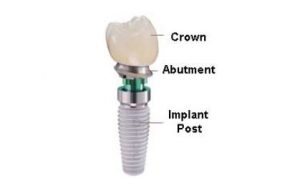
The three parts of a dental implant include the post, the abutment, and the crown
Why is it important to place the right number of dental implants?
We all know that dental implant treatment is expensive. This is why everyone wants to know "what's the fewest number of dental implants I need to replace my missing teeth?" The idea of getting fewer dental implants may seem appealing. Spending less money to get more teeth is always an attractive option. However, skipping out on receiving the right number of implants may prove to be a costly solution. We expect our dental implants to last a lifetime. It's important to plan your implant treatment for long-term success. This means that you need to make sure that there are enough implant posts to support your bite force. Failing to place enough implant posts overloads your implants which may cause them to fail. Let's take a closer look to examine how many dental implants you need to replace your missing teeth.
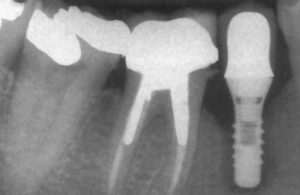
Example of a failed dental implant that shows significant bone loss surrounding the failed implant
How many implant posts do I need to replace my teeth?
If you are missing one tooth then you need one dental implant. This is an easy one. But if you are missing two teeth? Can you get away with placing one implant screw and two teeth on top? What if you are missing three teeth? Do you need 1, 2, or 3 implant posts to replace your missing teeth? And finally, how many implants do you need to replace all of your missing teeth? Obviously, each case is different and your dentist will guide you in the right direction. Still, it's important to understand how bite forces work. Each implant post can handle so much force. The more implant posts you have, the more support your bite will have going forward. Therefore, you need to make sure that there are enough implant posts to support your bite forces properly. Here are some things to take into consideration when deciding on how many implant posts you need to fix your mouth:
Number of Missing Teeth
The more teeth you have missing, the more implant posts you need to replace the missing teeth. Let's take a look at a few sample scenarios:
- Missing one tooth - If you're missing one tooth, then you need a single implant post to replace the missing tooth.
- Missing two teeth - If you're missing two back teeth then it's preferable to place two separate posts with two separate crowns. On the other hand, if you're missing two front teeth next to each other then you might be able to get away with just one implant post that supports both crowns (unless you're missing an upper canine tooth in which case you should place two separate implant posts).
- Missing three teeth - When you're missing three adjacent teeth, you have two options. You can either place three implant posts with three crowns, or two implant posts with a 3-unit implant bridge on top. Talk to your dentist to see which is the better option for your mouth.
- All of your teeth in one arch - You can replace all of your missing teeth in the top or bottom using as little as four dental implant posts. There are occasions where it does make sense to put a 5th or 6th implant post as well.
You may have noticed that it's not always a 1:1 ratio between implant posts and the number of missing teeth. You don't need as many implant posts as teeth missing. In fact, you can replace all of your missing teeth using the all-on-4 implant technique by placing as little as four implant posts. This means that you can support 12 to 14 prosthetic teeth using only four implant posts. Of course, each case is unique, so be sure to consult with your dentist to see exactly how many implant posts you require.
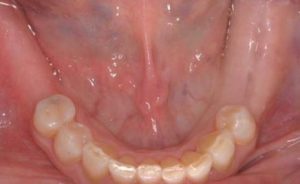
The more teeth you're missing, the more implant posts you need to replace the missing teeth
Position of the Missing Teeth
Another important factor to take into consideration is the location of your missing teeth. Replacing the back teeth always requires more implant posts as compared to the front teeth. This is because your back teeth are responsible for chewing and crushing food. As a result, the back teeth receive significantly more force than the front teeth do. Let's look at a scenario for replacing four teeth in the front versus the back:
- Missing 4 front teeth - If you're missing the front four teeth, you can usually replace them by placing just two implant posts that support a 4-unit bridge. Two implant posts are more than enough to handle the bite force in the anterior region since these teeth are only used for cutting food.
- Missing 4 back teeth - If you're missing four consecutive back teeth then we recommend placing four individual implant posts whenever possible. Placing implant posts at a 1:1 ratio allows the posts to better absorb and distribute your bite forces. This protects your implants over time. You can also consider placing three implant posts with a 4-unit implant bridge on top. However, placing a four-unit bridge on top of just two implant posts is not advisable in the back of the mouth. A bridge like this is very likely to fail within a few years due to excess forces exerted onto the implant posts.
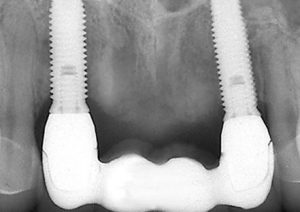
If the missing your front four teeth, you can replace them using just two implant posts
Detrimental Oral Habits
Certain oral habits can impact your decision-making when it comes to how many dental implant posts you need. For example, heavy teeth grinders place significantly more pressure on their teeth. The same goes for those who suffer from a collapsed bite or orthodontic issues. If this applies to you, you need to place more implant posts to withstand the additional stress. Otherwise, there's a chance that your implant posts become overloaded and the implants will fail within several years.
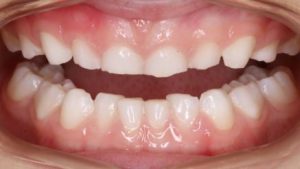
Heavy teeth grinders should consider placing as many implant posts as they possibly can
Jawbone Quality & Quantity
Lack of sufficient jawbone makes it difficult or even impossible to restore your mouth with dental implants. Ideal treatment involves restoring the missing bone first, then placing the implant posts. This requires bone grafting to restore the missing jawbone. However, advanced bone grafting is an extensive treatment. Not every patient wants to spend one to two years building up their jawbone in preparation for implant treatment. Luckily, there is a shortcut here in some situations. In some cases, you can simply add one or two implant posts to compensate for the insufficient jawbone. For instance, sometimes you can place multiple short implants under the sinus membrane to avoid performing a complex sinus grafting procedure. Another example is the all-on-four teeth concept. By placing just four dental implants in the anterior region, you avoid having to restore the missing bone in the posterior area while still receiving teeth in the posterior region.
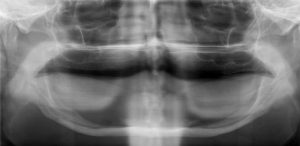
Placing additional implant posts can somewhat make up for the lack of high-quality jawbone
Number of Posterior Contacts
The average person with a full set of teeth, not counting the wisdoms, has four posterior teeth that make contact with each other on the right and four more on the left side of his or her mouth. This results in a total of eight posterior contact points. If you lose one back tooth, you lose one posterior contact. Having less than six posterior contacts, or three on each side, jeopardizes your teeth by increasing the stress on the remaining teeth. Therefore, you should always aim to keep at least three contact points on each side of the mouth. This concept is very important in placing dental implants. Each implant post counts as one tooth root. We recommend that you place enough implant posts to equate to at least three roots/ implant posts on each side of the mouth. Not placing enough implant posts causes your teeth or implants to get overstressed. This may lead to implant failure or damage to the remaining teeth over time.
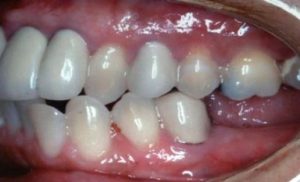
You want to have at least 3 chewing teeth on each side to support the bite forces
Hopefully, this helps you get an idea of how many implants you need to replace your missing teeth. Ultimately, your dentist needs to perform a full examine to answer this question. There are many factors to consider. Only with the right exam, can you and your dentist determine how many implants are needed to replace your missing teeth.
0 Comments